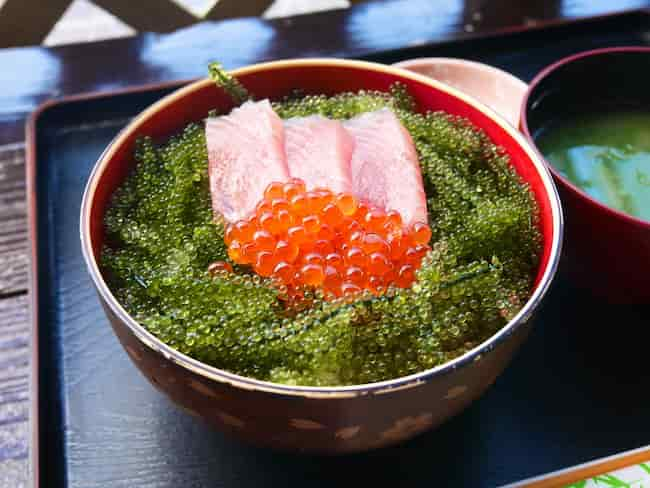What Is Tobiko:
Tobiko is a flying fish Roe, also known as Caviar. Tobiko is often used as a sushi or sashimi ingredient and bright orange color. The eggs are small, about 1mm in diameter, and slightly crunchy texture. They are generally considered a delicacy.
Nutritional value:
Tobiko is high in protein and omega-3 fatty acids. One hundred grams of Tobiko provides approximately 23 grams of protein and 8,700 milligrams of omega-3 fatty acids. It also contains some vitamin A, iron, and calcium.
Health benefits:
Omega-3 fatty acids are beneficial for maintaining heart health and preventing chronic diseases such as cancer. Eating fish is often recommended to consume omega-3 fatty acids because they are not as readily available in other types of food. Tobiko also contains protein, which is essential for building and repairing body tissues, controlling fluid balance, and transporting oxygen throughout the body.
How Tobiko is healthy:
Tobiko has an amazing nutritional makeup: high in protein and omega-3 fatty acids – two things most people don’t get enough of – and low in carbs and calories. A 3-ounce serving (about 100 grams) provides close to 23 grams of protein (4% DV), 8700 milligrams of omega-3 fatty acids (463% DV), Vitamin A (30% DV), iron (23% DV), and calcium (23% DV). The only downside is the high sodium content, but that should be easy to manage by limiting your intake.
Tobiko’s protein content isn’t just impressive for a fish – it’s also remarkable for any food. This makes Tobiko an excellent source of dietary protein. Not to mention, it’s also rich in omega-3 fatty acids. Omega-3s are great for heart health and have been shown to support brain function. Tobiko is an excellent source of Vitamin A (30% DV per serving) and a good source of calcium and iron content (23% DV per serving).
Tobiko is low in carbs – only 1 gram per serving – but high in sodium. The American Heart Association recommends limiting daily sodium intake to 1500 mg; 3 ounces of Tobiko has 992 mg (almost half the recommended daily amount). It also provides all the other macronutrients: 14 grams of fat, 0 grams of fiber, and nearly 20 grams of protein per 100-gram serving. Fish Roe products are high in protein and excellent staple food to keep around the house. They’re also a good source of omega-3 fatty acids, so they should be included in a healthy diet.
Tobiko vs. Caviar:
The terms “tobiko” and “caviar” are often used interchangeably, but there is a difference. Caviar refers to the eggs of any fish, while Tobiko refers explicitly to the eggs of the flying fish. Caviar is considered a delicacy and quite expensive, while Tobiko is more affordable. Caviar is also considered to be of higher quality than Tobiko.
Where to buy Tobiko:
Tobiko can be found at most grocery stores or Asian markets. It is generally sold in either a jar or a container. Prices vary but expect to pay around $10-$15 per jar.
In conclusion, Tobiko is an excellent source of protein, omega-3 fatty acids, and other essential nutrients. It’s low in carbs and calories, making it a healthy choice for people on a weight loss diet. Tobiko is also a good choice for people who want to increase their intake of omega-3 fatty acids. It can be found at most grocery stores Asian markets. Prices vary but expect to pay around $10-$15 per jar.
Tobiko vs. Masago:
Tobiko and Masago are two variations of fish eggs. Tobiko refers to flying fish eggs, while masago refers to the smelt eggs. Masago is generally smaller than Tobiko, but they can be challenging to tell apart. Tobiko’s texture is a little crunchier, but it’s a matter of personal preference as both foods have a crispy texture when fried. It should also be noted that Tobiko is more commonly used as a sushi topping while masago may be found in Japanese dishes such as chirashi or gunkan maki.
Tobiko vs. Roe:
Both Tobiko and Roe refer to the eggs that come from certain types of fish. However, there are some differences between the two. Roe is the eggs of any fish, while Tobiko specifically refers to flying fish eggs. Tobiko is also commonly used as a sushi topping, while Roe may be found in dishes such as chirashi or gunkan maki.
Tobiko vs. ikura:
Tobiko and ikura are both typical toppings for sushi that come from certain types of fish. However, there are some differences between the two. Tobiko generally comes from flying fish (which is why it’s sometimes referred to as “flying fish roe”), while ikura comes from salmon trout.
The calorie content can vary depending on what type of fish they come from; however, since they’re often served with sushi, both are generally low in calories.
